Quantum entanglement: Three twisted light particles uncover a new generation of superfast computers

Quantum physics has taken another leap forward as scientists successfully entangle three particles of light. This pattern has never been seen before in more than two particles of light, and potentially gives rise to a whole new level of quantum communication.
The research, published in the journal Nature Photonics, shows how three separate particles of light move together in synchronisation, something only previously imagined on paper. The findings could pave the way to new, superfast computers – even a whole new internet.
Quantum figure skaters
The researchers, from the University of Vienna, used ice dancers to illustrate their findings.
Imagine a figure skater spinning clockwise on the ice. Now try to imagine that skater spinning both clockwise and anticlockwise at the same time. As difficult as it seems, that is what is happening in one single photon – a particle of light.
Now, an identical figure skater (photon) appears and both are spinning in exactly the same way, at exactly the same time. Even though the skaters are gradually being pulled further and further apart, they still continue to spin in unison.
"The entangled photons in our experiment can be illustrated by not two, but three such ice dancers, dancing a perfectly synchronized quantum mechanical ballet," said Mehul Malik, researcher working on the study.
All three photons act in exactly the same way; giving rise to "asymmetric quantum entanglement".
Photons have been entangled before, but this is the first time more than two photons have been entangled. Previous attempts only managed to include two photons to create an "on" or "off" effect.
However, the scientists found a way to add the elusive third photon, and still make them act synchronised.
The study
The scientists entangled two photons, and then heated them to more than 120 degrees Celsius. This meant they began to move incredibly fast.
These photons were then "twisted", so that they began to corkscrew; similar to the shape of DNA.
This meant the third photon was able to join in the dance, and operate asymmetrically with the other two.
"The experiment opens the door for a future quantum internet with more than two partners and it allows them to communicate more than one bit per photon," said Anton Zeilinger, co-author of the study."
© Copyright IBTimes 2025. All rights reserved.






















